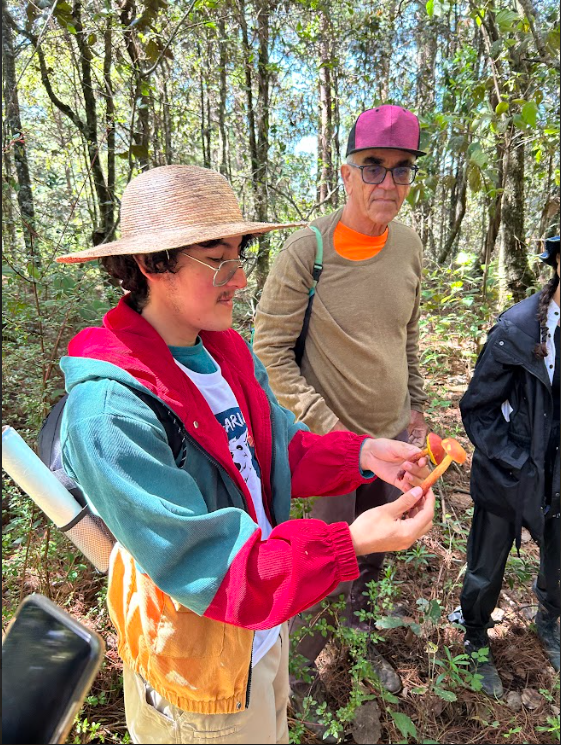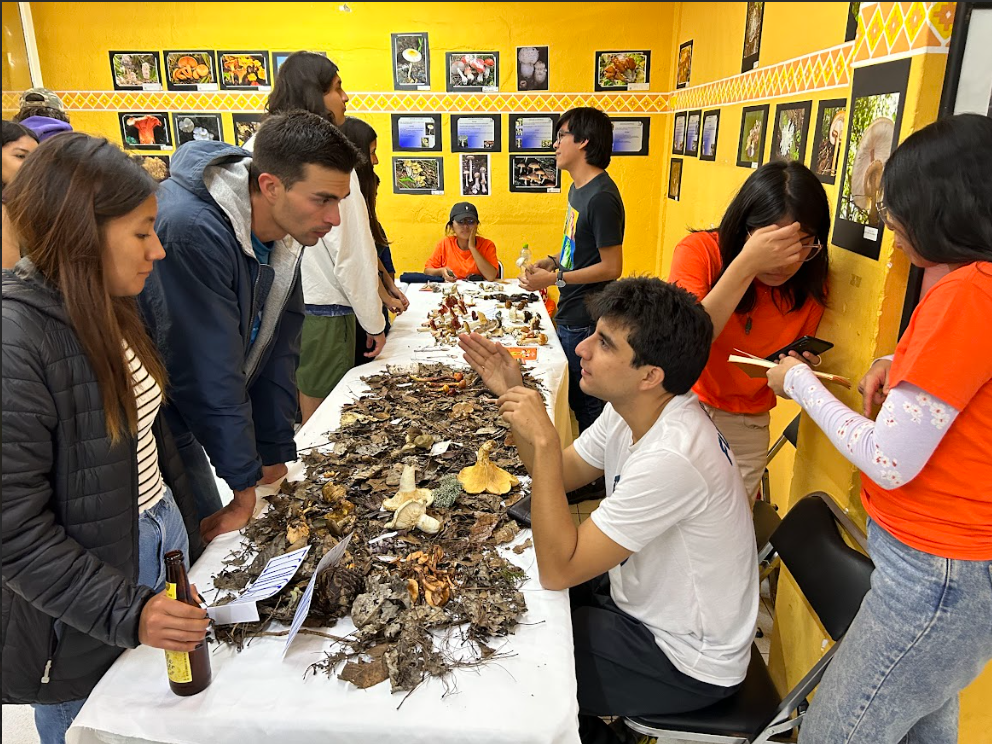Photos Courtesy of Author
The first annual community mushroom festival titled “Yuy Fest” just wrapped up in the historic center of San Cristóbal de Las Casas, Chiapas.
‘Yuy’ is the Tzotzil indigenous word for ‘Amanita’, a genus of mushrooms that contains over 600 species including the fabled Amanita Muscaria, a psychoactive red and white mushroom with thousands of years of folklore around the world behind it.
The five-day festival drew an estimated 1,000 attendees per day and featured a stacked lineup of fungi workshops including mushroom pigment and paper making, a craft fair with vendors selling handmade mushroom earrings and Cordyceps mezcal, fungi film screenings, lectures from world-renowned academic researchers, and forays into the cloud forest reserves just outside of town in search of edible culinary mushrooms such as the prized Hypomyces lactifluorom (known colloquially as the ‘Lobster Mushroom’) Russolas, Boletus, and Amanitas of many different shapes and sizes. There were also workshops on the ethnomycological history of psilocybin mushroom use across Indigenous cultures in Central and Southern Mexico, as well as insights into the state of modern medical research into psilocybin by institutions like Johns Hopkins and Imperial College London.
 The festival included four mushroom collection expeditions to four distinct natural reserves in the mountains surrounding San Cristóbal de las Casas. During these forays, we found several previously unidentified species of the robust funga here. With an estimated 50,000 fungi in the state – only 2% of which have been identified – there are new finds and mushroom recordings for Chiapas virtually every foray. Many of the fungi are known to the local indigenous communities, but interest in foraging wild mushrooms has subsided drastically over the last generation due to the encroachment of globalization and active government campaigns in the region discouraging the foraging of wild mushrooms.
The festival included four mushroom collection expeditions to four distinct natural reserves in the mountains surrounding San Cristóbal de las Casas. During these forays, we found several previously unidentified species of the robust funga here. With an estimated 50,000 fungi in the state – only 2% of which have been identified – there are new finds and mushroom recordings for Chiapas virtually every foray. Many of the fungi are known to the local indigenous communities, but interest in foraging wild mushrooms has subsided drastically over the last generation due to the encroachment of globalization and active government campaigns in the region discouraging the foraging of wild mushrooms.
“Funga” is the most appropriate term for the kingdom of fungi, because they aren’t flora or fauna, but rather a distinct and infinitely important contributor to ecosystems worldwide. This new label has been adapted by research and professional institutions worldwide, and is increasingly being adopted by legislature and environmental policy initiatives.
A dynamic team of Chiapanecan fungi experts collectively known as Fungaria led the forays, educating the 30 plus foragers in attendance about the phylogeny, taxonomy, and ethnomycological aspects of the many diverse species of fungi that we encountered.
The finds were separated into distinct baskets distinguishing the toxic from the edible from the mycorrhizal fungi and brought afterwards to the main event hall where workshops and vendors congregated. They were then displayed on tables for conference attendees to examine and learn about from local student mycologists.
In total, over a hundred different species were collected throughout the forays, including many choice edible species that were then turned into a variety of delectable dishes by resident chef Karla Jiménez Patishtán.
Yuy Fest was the brainchild of a growing movement of devoted mycologists and mushroom enthusiasts both homegrown and imported who have made mushrooms a focal point in their lives. Each of the few academic researchers specializing in Chiapanecan fungi were present, providing for a dense yet approachable concentration of Chiapas fungi expertise throughout the festival.
Dr. Felipe Ruan Soto, the world’s foremost academic authority on the mushrooms of Chiapas, provided cutting edge insights into the Funga of Chiapas alongside celebrated mycologist Marisa Ordaz-Velázquez.Their presence lended a scientific legitimacy and expertise to the festival that only comes from decades of combined experience studying the marginalized arena of Chiapanecan fungi.
On the first foray of the week, we were joined by a local representative of the reserve who identified each of the different mushrooms in his native Tzotzil language alongside their identification in Latin, Spanish and English by Fungaria team leaders Ezequiel Cruz and Alex Estrada. This type of cross cultural magic is one of the trademark characteristics of the abundant Yuy Fest magic. The confluence of worldviews spanned multiple vastly different etymological and cultural lineages, each centered around the same mysterious mushrooms at hand.
 In some cases, the park rangers were unaware that certain familiar mushrooms were indeed edible. They expressed surprise as it was pointed out that the tiny delineations on the cap of a particular species of Amanita distinguishes it from the deadly Amanita phalloides – alternately known as the death cap – from another edible Amanita. It’s best to exercise an abundance of caution when foraging wild mushrooms, and so the foray leaders emphasized that unless an expert is present, novice foragers should steer clear of picking and eating any of the mushrooms that have toxic lookalikes.
In some cases, the park rangers were unaware that certain familiar mushrooms were indeed edible. They expressed surprise as it was pointed out that the tiny delineations on the cap of a particular species of Amanita distinguishes it from the deadly Amanita phalloides – alternately known as the death cap – from another edible Amanita. It’s best to exercise an abundance of caution when foraging wild mushrooms, and so the foray leaders emphasized that unless an expert is present, novice foragers should steer clear of picking and eating any of the mushrooms that have toxic lookalikes.
Beyond the forays, the popular mushroom themed restaurant K’an Kan served up Lion’s Mane burritos and Oyster Mushroom burgers to the swelling crowds filtering through the Yuy Fest exhibition hall. K’an K’an is a hub for mushroom lovers and gourmands alike, and serves as a gathering place for mycophiles from all over the world. Their in-house library features such fungi classics as Radical Mycology by Peter McCoy, Mycelium Running by Paul Stamets, and How to Change Your Mind by Michael Pollan among others.
At the vendors fair, mushroom brands such as Aleación Fun and Mama Funga offered tinctures extracted from the fruiting bodies of medicinal mushrooms such as Cordyceps, Reishi, and Lion’s Mane and mushroom-infused chocolate. Local San Cristóbal cultural treasure Carlos Cea live painted his famous murals that are found all over town while offering a selection of original paintings for sale.
The mushroom culture in the Chiapas highlands and throughout the state has thousands of years of history to it, and is threatened by the encroaching monopoly of globalization and its homogeny of brand saturation and market-oriented values. The wild mushroom vendors that used to line up and sell ‘canastas’ full of freshly picked edible Lactarius indigo and Armillaria honey fungus mushrooms have been disappearing from markets throughout the state, replaced by stalls selling shrink-wrapped Button mushrooms and other fare produced at massive industrialized hubs out of state somewhere.
But just as the ancient traditions of mushroom use across southern and central Mexico are on the verge of erasure, a massive surge of interest in ethnomycology and scientific inquiry into the Funga of Mexico has taken the region by storm over the past few years. Mushroom fairs and mycology conferences are popping up throughout the country, and a homegrown crop of new devotees and students of the mushroom are emerging faster than a honeypot of Yuyo (Amanita hayulyuy) after a bout of rain.
Over 1,000 people a day are estimated to have come through Yuy Fest thanks to its prominent location on the Andador Guadalupe, the main pedestrian street in the historic center of San Cristóbal de las Casas. The five-day conference was an overwhelming success, and the spirit of mushroom enthusiasm and exploration is more alive than ever in this Pueblo Mágico surrounded by mountains containing tens of thousands of mushroom species and millennia of Indigenous fungi knowledge. And next year’s Yuy Fest promises to be even better.


